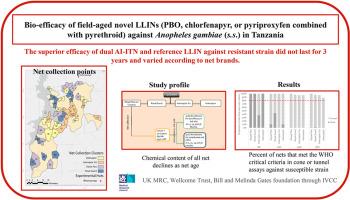Evaluation of bio-efficacy of field-aged novel long-lasting insecticidal nets (PBO, chlorfenapyr or pyriproxyfen combined with pyrethroid) against Anopheles gambiae (s.s.) in Tanzania
IF 1.7
Q3 PARASITOLOGY
Current research in parasitology & vector-borne diseases
Pub Date : 2024-01-01
DOI:10.1016/j.crpvbd.2024.100216
引用次数: 0
Abstract
Next-generation insecticide-treated bed nets (ITNs) combining two insecticides or an insecticide with a synergist are vital in combating malaria, especially in areas with pyrethroid-resistant mosquitoes where standard pyrethroid long-lasting insecticidal net (LLIN) may be less effective. A community durability study was conducted in Misungwi, Tanzania, during a cluster randomised controlled trial. This study assessed the bio-efficacy of three net brands combining a pyrethroid insecticide and either a synergist PBO for Olyset Plus, or a second insecticide pyriproxyfen for Royal Guard, and chlorfenapyr for Interceptor G2 over three years. These nets were compared to Interceptor, a standard pyrethroid-only net. A total of 1950 nets were enrolled across 10 clusters in each treatment arm. Thirty nets per type were collected every 6 months up to 30 months, with 50 nets sampled at 36 months. WHO cone bioassays and tunnel tests were performed at 0, 12, 24, 30 and 36 months. Both susceptible An. gambiae (s.s.) Kisumu strain and resistant An. gambiae (s.s.) Muleba-Kis strain were exposed. Over 80% of nets tested against the susceptible Kisumu strain met the WHO criteria after three years of community use. In tunnel tests, mortality (72 h) of the resistant Anopheles varied between 52% and 20%, in Interceptor G2 and was higher than standard Interceptor net up to 24 months. Olyset Plus mortality (24 h) ranged between 84% and 33% in tunnel tests with superior efficacy compared to Interceptor at 0, 24 and 36 months. Sterility effects in Royal Guard were higher when these nets were new and at six months but decreased to less than 10% after 12 months. Royal Guard consistently induced higher mortality compared to Interceptor up to 30 months while next-generation ITNs demonstrated higher efficacy in terms of mortality compared to standard LLINs against resistant strains; this superior bio-efficacy did not persist for the full three years. The impact of active ingredient (dual-AI) and PBO diminished relatively quickly. Aside from the initial period when the nets were new, the differences in mortality for Interceptor G2 and Olyset Plus and in sterility for Royal Guard, compared to the standard LLINs, were relatively small thereafter.

评估坦桑尼亚田间使用的新型长效杀虫蚊帐(PBO、氯虫苯甲酰胺或吡丙醚与拟除虫菊酯复配)对冈比亚按蚊的生物效力
新一代驱虫蚊帐(ITNs)结合了两种杀虫剂或一种杀虫剂和一种增效剂,对防治疟疾至关重要,尤其是在有抗拟除虫菊酯蚊子的地区,标准的拟除虫菊酯长效驱虫蚊帐(LLIN)的效果可能较差。在集群随机对照试验期间,在坦桑尼亚米松圭开展了一项社区耐久性研究。这项研究评估了三个品牌的蚊帐在三年内的生物功效,这三个品牌分别是:Olyset Plus 使用拟除虫菊酯杀虫剂和增效剂 PBO,Royal Guard 使用第二种杀虫剂吡丙醚,Interceptor G2 使用氯虫苯甲酰胺。这些蚊帐与只使用除虫菊酯的标准蚊帐 Interceptor 进行了比较。每个处理组的 10 个群组共使用了 1950 张蚊帐。在 30 个月内,每 6 个月对每种类型的 30 顶蚊帐进行收集,在 36 个月时对 50 顶蚊帐进行取样。在 0、12、24、30 和 36 个月时进行了世界卫生组织锥形生物测定和隧道测试。易感冈比亚蚁(s.s.)基苏木品系和抗性冈比亚蚁(s.s.)穆莱巴-基斯品系都受到了影响。在社区使用三年后,针对易感的基苏木菌株测试的蚊帐有 80% 以上符合世卫组织的标准。在隧道测试中,Interceptor G2 的抗药性按蚊死亡率(72 小时)介于 52% 和 20% 之间,在 24 个月内高于标准 Interceptor 蚊帐。在隧道试验中,Olyset Plus 的死亡率(24 小时)介于 84% 和 33% 之间,在 0 个月、24 个月和 36 个月时,其功效优于拦截网。皇家卫士的不育效果在新网和 6 个月时较高,但在 12 个月后下降到 10%以下。与 Interceptor 相比,Royal Guard 在 30 个月内持续诱发更高的死亡率,而与标准长效驱虫蚊帐相比,下一代驱虫蚊帐对抗药性菌株的死亡率表现出更高的功效;这种卓越的生物功效并没有持续整整三年。活性成分(双 AI)和 PBO 的影响相对较快减弱。除了新蚊帐使用初期,与标准长效驱虫蚊帐相比,Interceptor G2 和 Olyset Plus 的死亡率以及 Royal Guard 的无菌率差异相对较小。
本文章由计算机程序翻译,如有差异,请以英文原文为准。
求助全文
约1分钟内获得全文
求助全文

 求助内容:
求助内容: 应助结果提醒方式:
应助结果提醒方式:


